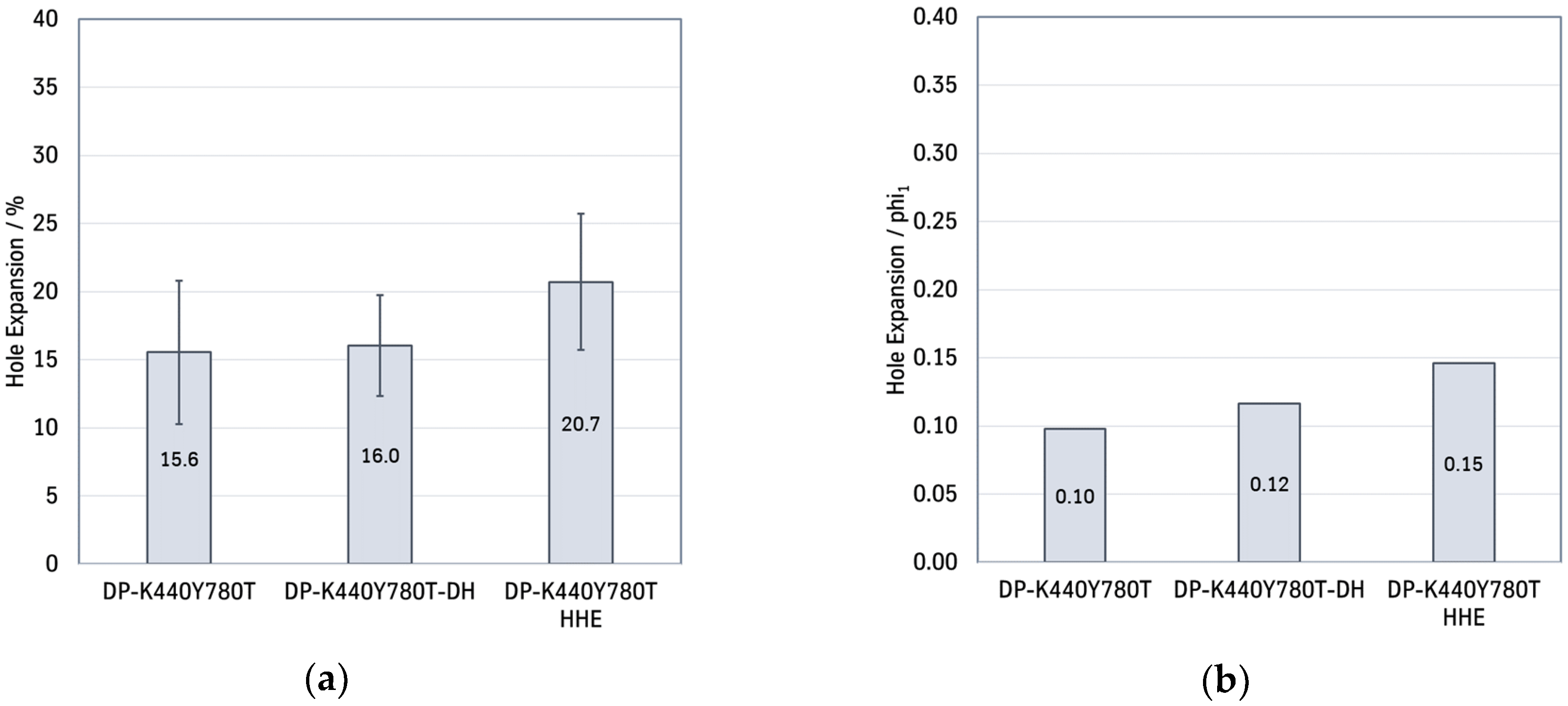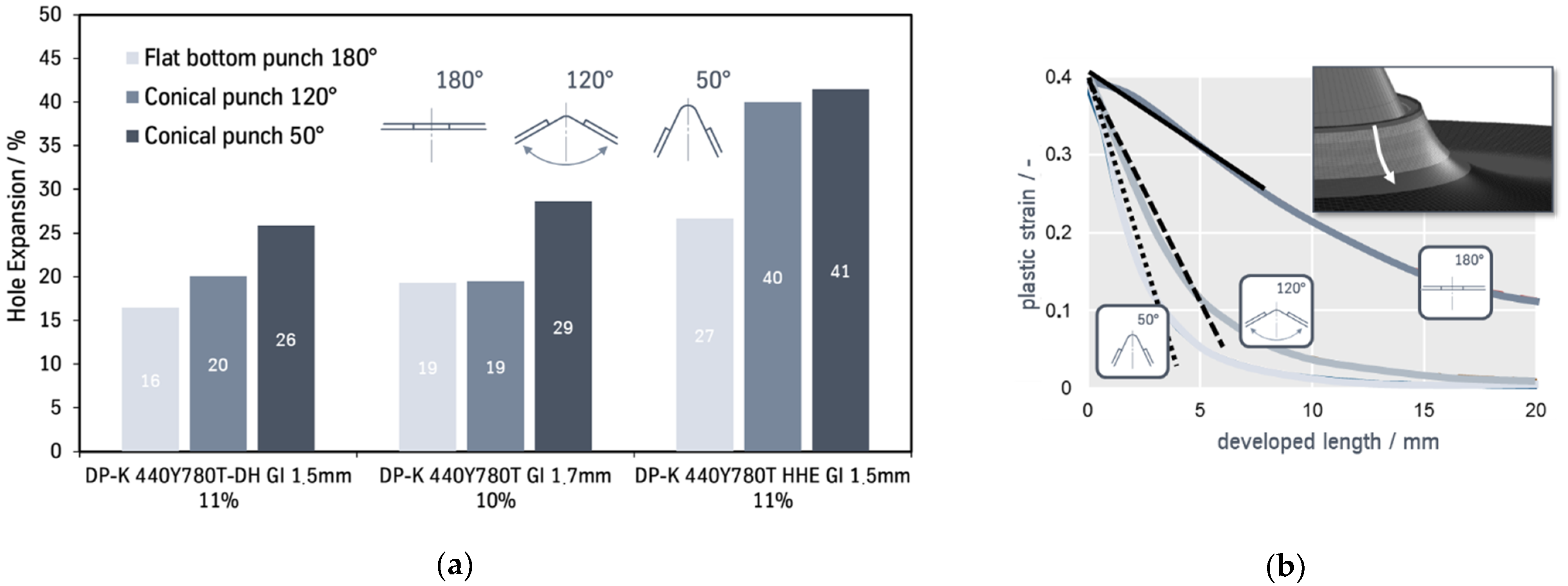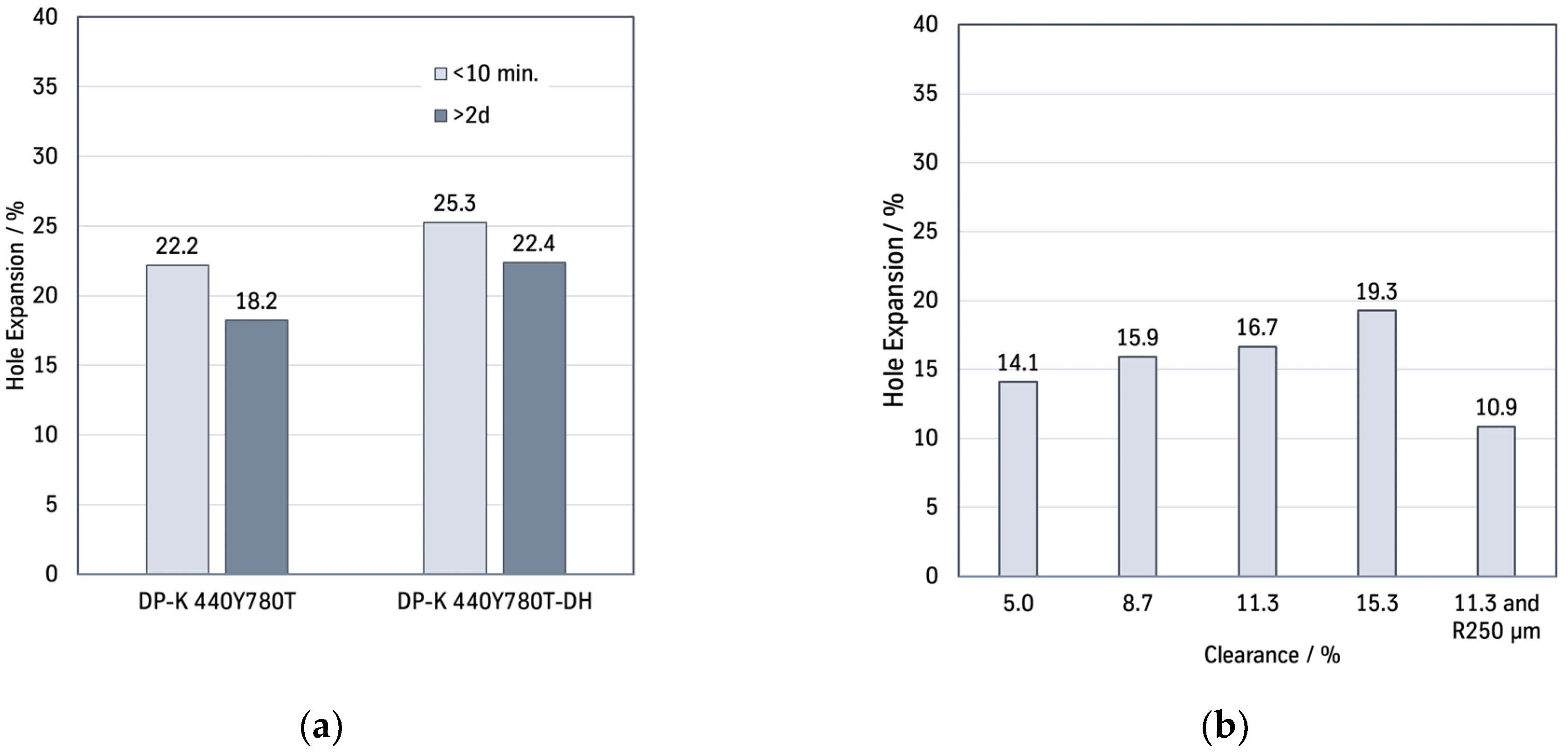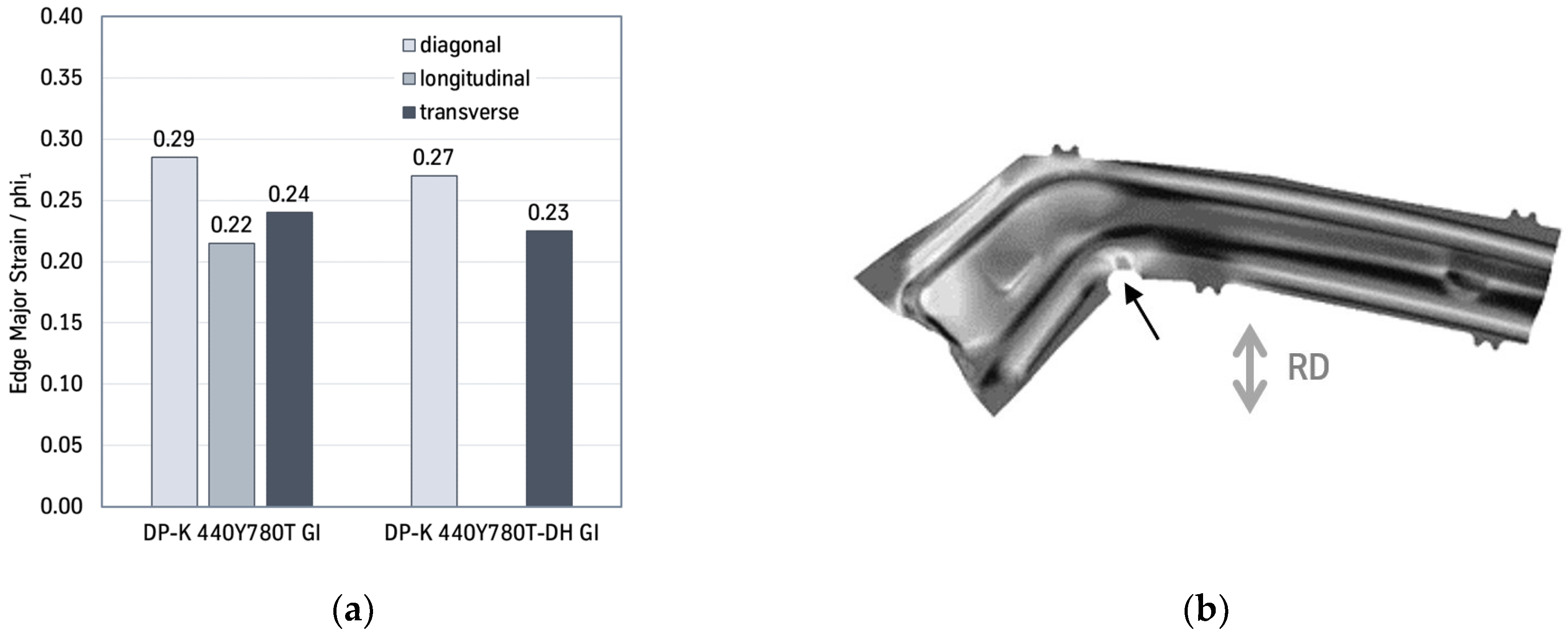Forming Potential of Current Dual-Phase Steel Developments with Strengths of 800 MPa †
Abstract
1. Introduction
2. Materials: Dual-Phase Steels with Tensile Strength of 800 MPa
- DP-K 440Y780T-DH: Improved balanced local and global formability
- DP-K 440Y780 HHE: Optimized for local formability
3. Stretch Flange Formability—Test Method & Test Results
4. Advantages in Part Design
5. Summary and Conclusions
Author Contributions
Funding
Institutional Review Board Statement
Informed Consent Statement
Conflicts of Interest
References
- Standards Committees. VDA 239-100: Flacherzeugnisse aus Stahl zur Kaltumformung/Sheet Steel for Cold Forming (Version 06/2016); Standards Committees: Berlin, Germany, 2011. [Google Scholar]
- Dual-Phase Steels—Tailored Portfolio for Modern Lightweight Construction. Available online: https://www.thyssenkrupp-steel.com/en/products/sheet-coated-products/multiphase-steel/dual-phase-steel/ (accessed on 1 August 2020).
- Hance, B.M.; Link, T.M. Effects of Fracture Area Measurement Method and Tension Test Specimen Type on Fracture Strain Values of 980 Class AHSS. In IOP Conference Series: Materials Science and Engineering; IOP Publishing: Bristol, UK, 2019; Volume 651, p. 012061. [Google Scholar]
- Hance, B.M. Practical Application of the Hole Expansion Test. SAE Int. J. Engines 2017, 10, 247–257. [Google Scholar] [CrossRef]
- Hance, B.M. Advanced High Strength Steel: Deciphering Local and Global Formability. In Proceedings of the International Automotive Body Congress, Dearborn, MI, USA, 28–29 September 2016. [Google Scholar]
- Heibel, S.; Dettinger, T.; Nester, W.; Clausmeyer, T.; Tekkaya, A.E. Damage Mechanisms and Mechanical Properties of High-Strength Multiphase Steels. Materials 2018, 11, 761. [Google Scholar] [CrossRef] [PubMed]
- Larour, P.; Freudenthaler, J.; Weissböck, T. Reduction of cross section area at fracture in tensile test: Measurement and applications for flat sheet steels. J. Phys. Conf. Ser. 2017, 896, 012073. [Google Scholar] [CrossRef]
- Standards Committees. International Standard ISO 16630: Metallic Materials–Sheet and Strip–Hole Expanding Test; Standards Committees: Berlin, Germany, 2017. [Google Scholar]
- Standards Committees. VDA 238-100: Plättchen-Biegeversuch für Metallische Werkstoffe/Plate Bending Test for Metallic Materials (Version 07/2020); Standards Committees: Berlin, Germany, 2020. [Google Scholar]
- Standards Committees. DIN EN ISO 6892-1: Zugversuch, Prüfverfahren bei Raumtemperatur für metallische Werkstoffe; Standards Committees: Berlin, Germany, 2016. [Google Scholar]
- Beier, T.; Woestmann, S. Berücksichtigung von schergeschnittenen Blech-kanten zur Auslegung von Formgebungsprozessen höherfester Stahlwerkstoffe in der FEM-Umformsimulation. In Proceedings of the 14th German LS-DYNA Forum, Bamberg, Germany, 10–12 October 2016. [Google Scholar]
- Iizuka, E.; Urabe, M.; Yamasaki, Y. Effect of strain gradient on stretch flange deformation li-mit of steel sheets–Prediction method of cut edge failure. In Proceedings of the Umformen im Karosseriebau, Bad Nauheim, Deutschland, 29–30 September 2015. [Google Scholar]
- Atzema, E.; Seda, P. Effect of zinc coating and time on edge ductility. In Proceedings of the 5th International Conference on Steels in Cars and Trucks, Amsterdam, The Netherlands, 18–22 June 2017. [Google Scholar]
- Iizuka, E.; Hashimoto, K.; Kuwabara, T.; Ishiwatari, A.; Inazumi, T. Effects of anisotropic yield functions on the accuracy of forming simulations of hole expansion. Procedia Engineering 2014, 81, 2433–2438. [Google Scholar] [CrossRef]
- Braun, M.; Atzema, E.; Beier, T.; Bülter, M.; Brockmann, S.; Larour, P.; Müller, T.; Neuhaus, R.; Richter, A.; Schneider, M. Umformsimulation unter Einbeziehung einer verminderten Umformbarkeit schergeschnittener Stahlblechkan-ten–Wirksamkeit von 3 verschiedenen Kantenriss-Kennwerten und 3 Software-Systemen im Realversuch. In Proceedings of the Umformen im Karosseriebau, Bad Nauheim, Deutschland, 28 September 2016. [Google Scholar]










| Classic | Ductility High | High Hole Expansion | |||||||
|---|---|---|---|---|---|---|---|---|---|
| DP-K 440Y780T | DP-K 440Y780Y-DH | DP-K 440Y780T-HHE | |||||||
| RD [°] | L | D | T | L | D | T | L | D | T |
| Thickness [mm] | 1.51 | 1.51 | 1.51 | 1.51 | 1.51 | 1.51 | 1.51 | 1.55 | 1.53 |
| YS [MPa] | 468 | 469 | 470 | 480 | 497 | 518 | 537 | 545 | 574 |
| TE [%] | 19.1 | 18.3 | 16.6 | 20.3 | 21.4 | 18 | 17.9 | 19.3 | 18.3 |
| UE [%] | 12.1 | 12.3 | 11.4 | 13.6 | 14.2 | 12.8 | 10 | 10.5 | 9.9 |
| n-value [-] | 0.117 | 0.123 | 0.122 | 0.144 | 0.143 | 0.136 | 0.099 | 0.103 | 0.101 |
| r-value [-] | 0.8 | 0.84 | 0.91 | 0.72 | 0.99 | 0.86 | 0.68 | 1.04 | 0.82 |
| Test Run | Influencing Factors | Investigation Target, Test Procedure & Boundaries |
|---|---|---|
| 1 | Material scatter | Statistics on HER for in-plane hole expansion test determined from several coils using standard test parameters (hole ∅20 mm, cutting clearance 11–13%, time between cutting & forming >48 h) |
| 2 | Orthogonal strain gradient | HER resulting from different punch shapes/opening angles α (50°, 120°, 180°) for standard test parameters |
| 3 | Aging of the cutting edge | HER for in-plane hole expansion test with time lag <10 min and >48 h using standard cutting parameters |
| 4 | Cutting parameters | HER for in-plane hole expansion test for standard time between cutting & forming >48 h, in addition various cutting clearances and cutting punch radii |
| 5 | Rolling direction | HER for in-plane hole expansion test using bisected specimen 0° & 90° rolling direction using standard cutting parameters |
| Influencing Parameter | Customer Process (e.g.,) | Recommendation Max. Edge Strain phi1 [-] | Factor | ||
|---|---|---|---|---|---|
| DP-K440Y780T Classic | DP-K440Y780T DH | DP-K440Y780T HHE | |||
| Statistics (Mean Value—SD) In-plane hole expansion test | Different coils | 0.10 | 0.12 | 0.15 * | Basis |
| Orthogonal strain gradient | Low (Flange area) | 0.10 | 0.12 | 0.15 | ×1.0 |
| Aging of the cutting edge | Progressive tool, stamping directly from coil | 0.13 | 0.15 | 0.15 * | ×1.15 |
| Cutting parameters | Not perfect (Tool wear) | 0.10 | 0.12 | 0.15 * | ×0.85 |
| Rolling direction | Transverse (e.g.,) | 0.10 | 0.12 | 0.15 * | ×1.0 |
Publisher’s Note: MDPI stays neutral with regard to jurisdictional claims in published maps and institutional affiliations. |
© 2022 by the authors. Licensee MDPI, Basel, Switzerland. This article is an open access article distributed under the terms and conditions of the Creative Commons Attribution (CC BY) license (https://creativecommons.org/licenses/by/4.0/).
Share and Cite
Beier, T.; Linnepe, M.; Woestmann, S.; Sikora, S. Forming Potential of Current Dual-Phase Steel Developments with Strengths of 800 MPa. Eng. Proc. 2022, 26, 14. https://doi.org/10.3390/engproc2022026014
Beier T, Linnepe M, Woestmann S, Sikora S. Forming Potential of Current Dual-Phase Steel Developments with Strengths of 800 MPa. Engineering Proceedings. 2022; 26(1):14. https://doi.org/10.3390/engproc2022026014
Chicago/Turabian StyleBeier, Thorsten, Michael Linnepe, Stefan Woestmann, and Sascha Sikora. 2022. "Forming Potential of Current Dual-Phase Steel Developments with Strengths of 800 MPa" Engineering Proceedings 26, no. 1: 14. https://doi.org/10.3390/engproc2022026014
APA StyleBeier, T., Linnepe, M., Woestmann, S., & Sikora, S. (2022). Forming Potential of Current Dual-Phase Steel Developments with Strengths of 800 MPa. Engineering Proceedings, 26(1), 14. https://doi.org/10.3390/engproc2022026014





